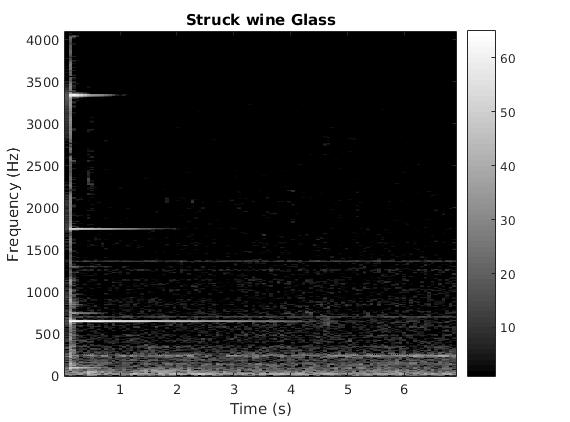I’ve been playing with the sounds crystal wine glasses can make, and noticed something interesting about the tones they emit when excited in different ways. The classic noise from a wine glass is making it ‘sing‘, by rubbing a wet finger along its rim. A series of tones / harmonics / normal modes will be excited by the vibration of the finger. These tones are a set of vibrational modes based on the material and shape of the glass (Crystal glass definitely helps.. possibly just because crystal wine glasses are thinner).
Everything and everyone has vibrational modes. They are how an object oscillates, or resonates naturally. Think of hitting a wooden table vs a drum head. They both make a certain sound, which is the sum of the normal modes of that object. What I noticed with the wine glass was that I could excite different modes by making it sing, vs striking it (flicking the rim with my finger).
I’ve been playing around with spectrograms, and this was a perfect reason to make one. A spectrogram is the frequency spectrum of a sound plotted over time. So I record the sound, and then choose a certain number of samples (somewhere less than 1000 samples at 44kHz), compute the discrete time fourier transform, and plot the positive frequencies along the vertical axis. Then take in another block of samples and do the same, plotting this time one column to the right. So what is shown on the plot is the frequency spectrum (vertically), evolving over time (horizontally). Each light horizontal streak is one normal mode of the wine glass. The low frequency noise (white ‘static’ near the bottom) is whatever got picked up from the background in the recording.
What’s interesting is that the base mode (lowest frequency) is the same for both types of excitement, but the higher modes change. This reinforces the fact that exciting objects in different ways excites different normal modes. Take a car for example. If it runs over a pot-hole, it will oscillate at a given frequency vertically. But if one slams the door, its going to oscillate at a different frequency. And this property, that objects vibrate differently depending on their stimulus, goes down even to the molecular level. Science!


